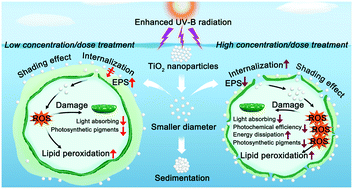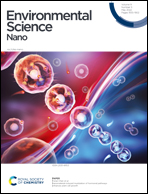UV-B radiation enhances the toxicity of TiO2 nanoparticles to the marine microalga Chlorella pyrenoidosa by disrupting the protection function of extracellular polymeric substances†
Abstract
Enhanced UV-B radiation (UVBR) has been a global environmental problem for decades due to stratospheric ozone depletion. Simultaneously, the potential environmental risks of TiO2 nanoparticles (NPs) have increasingly attracted attention. In the natural environment, marine microalgae could be simultaneously exposed to enhanced UVBR and TiO2 NPs. Owing to their photocatalytic properties, the toxicity of TiO2 NPs to marine microalgae might be exacerbated by UVBR. However, the combined effects and toxicity mechanisms of TiO2 NPs and UVBR on marine microalgae remain poorly understood. In this study, we investigated the bioavailability and toxicity of TiO2 NPs to the marine microalga Chlorella pyrenoidosa under UVBR. The results demonstrated that growth inhibition derived from TiO2 NPs was further enhanced by UVBR. Although UVBR accelerated the sedimentation of TiO2 NPs, the remaining suspended particles had smaller hydrodynamic diameters and caused stronger growth inhibition, indicating elevated effects of TiO2 NPs on algal cells after UVBR exposure because of the size-effect. Importantly, TiO2 NPs and UVBR showed a significant antagonistic interaction on the extracellular polymeric substances (EPS) secreted by C. pyrenoidosa with increasing concentration/dose, thus allowing more TiO2 NPs to enter the algal cells. The production of intracellular reactive oxygen species was triggered by internalized TiO2 NPs under UVBR exposure, resulting in lipid peroxidation and serious cellular damage in C. pyrenoidosa. Photosynthesis of C. pyrenoidosa was inhibited after exposure to TiO2 NPs combined with UVBR due to a combination of oxidative damage and NP shading. Overall, weakened EPS protection of algal cells, which contributed to the increased internalization of TiO2 NPs, was identified as the key mechanism for the enhanced toxicity of TiO2 NPs under UVBR conditions. This work provides new insights into the marine environmental risks associated with TiO2 NPs under increasing UVBR conditions.

- This article is part of the themed collection: SDG13: Climate Action – Ozone Depletion


 Please wait while we load your content...
Please wait while we load your content...